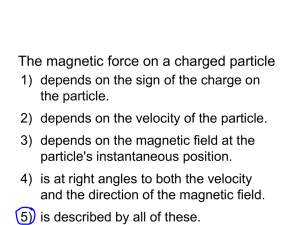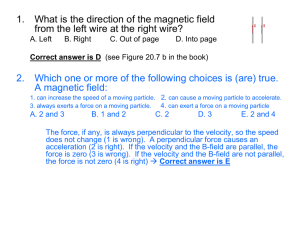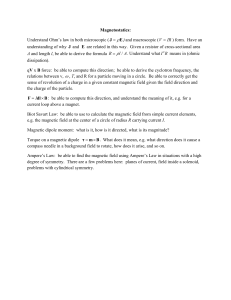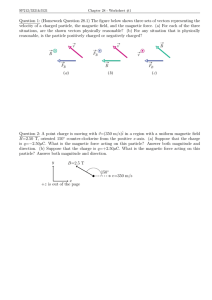Single Particle Motion
advertisement
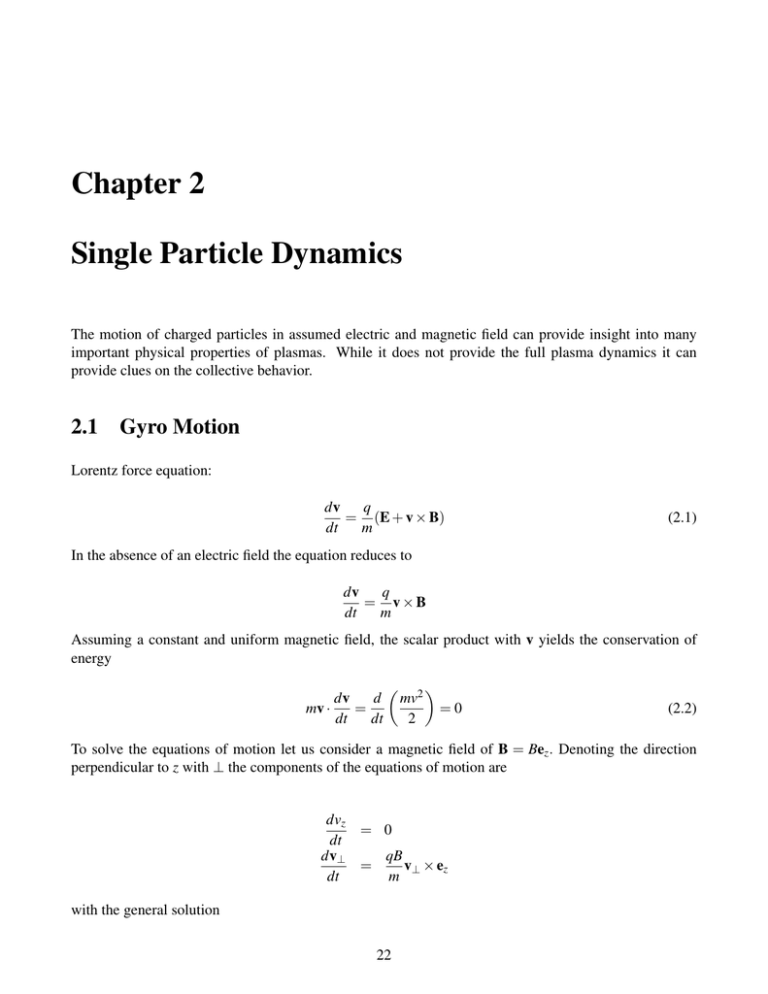
Chapter 2 Single Particle Dynamics The motion of charged particles in assumed electric and magnetic field can provide insight into many important physical properties of plasmas. While it does not provide the full plasma dynamics it can provide clues on the collective behavior. 2.1 Gyro Motion Lorentz force equation: q dv = (E + v × B) dt m (2.1) In the absence of an electric field the equation reduces to dv q = v×B dt m Assuming a constant and uniform magnetic field, the scalar product with v yields the conservation of energy dv d mv · = dt dt mv2 2 =0 (2.2) To solve the equations of motion let us consider a magnetic field of B = Bez . Denoting the direction perpendicular to z with ⊥ the components of the equations of motion are dvz = 0 dt dv⊥ qB = v⊥ × ez dt m with the general solution 22 CHAPTER 2. SINGLE PARTICLE DYNAMICS 23 B Figure 2.1: Helical ion trajectory in a uniform magnetic field. vx = v⊥ sin (ωgt + φ ) vy = v⊥ cos (ωgt + φ ) vz = vk (2.3) with v2⊥ = v2x + v2y and the trajectory x − x0 = − v⊥ cos (ωgt + φ ) ωg v⊥ sin (ωgt + φ ) ωg = vkt y − y0 = z − z0 (2.4) For vz0 = 0 the trajectories are circles in which the particles gyrate with a frequency of ωg = qB/m. (2.5) In vector form (using dv/dt = ωg × v) the particle angular velocity is ω g = −qB/m. Exercise: Show that the above equations for the particle velocity satisfy the Lorentz equation. With a finite velocity in z the trajectories are helical lines with the same gyro-frequency. The location of the center of the particle gyro motion (x0 , y0 , z) is called the guiding center of the particle motion. The gyro-radius for the particle motion is rg = v⊥ mv⊥ = . ωg |q|B (2.6) The angle of the particle trajectory with the magnetic field is called pitch angle α = tan−1 v⊥ vk (2.7) CHAPTER 2. SINGLE PARTICLE DYNAMICS 24 Ion E B Electron Figure 2.2: Illustration of the E × B drift. 2.2 2.2.1 Electric Field Drifts E × B Drift The discussion of the particle motion in the prior section is highly idealized because it assumes a uniform magnetic field, no other forces, and time independence for the magnetic field. The motion changes with these effects included. Let us first consider the presence of a uniform and time independent electric field E = Ek ez + Ex ex . This requires to consider the full Lorentz force equations. The motion parallel to the magnetic field can be separated from the perpendicular motion and describes a simple acceleration along the magnetic field. mdvz /dt = qEk (2.8) The equations for the perpendicular motion are dv⊥ qE⊥ q = + v×B dt m m (2.9) We can solve this equation either by explicit integration or finding a useful transformation in which the perpendicular electric field vanishes. Substituting v⊥ = u + w with a time constant component w the equation of motion becomes du qE⊥ q q = + w×B+ u×B dt m m m Choosing the velocity w such that electric force. qE⊥ m + mq vE × B = 0 reduces the equation for u to the case with no w = vE = E×B B2 (2.10) Thus a particle which drifts across the magnetic field with this so-called E × B drift does not feel the perpendicular electric field. Exercise: Derive the equations for the total particle velocity (gyro- and drift motion) for constant magnetic and electric fields B = B0 ez and E = E0 ex . Assume that the initial velocity is v = v0 ey . CHAPTER 2. SINGLE PARTICLE DYNAMICS 25 Compute the velocity v0 (as a function of magnetic and electric fields) for which there is no gyro motion. Discuss the cases and sketch the particle orbit if the initial velocity along y is larger or smaller than the value for which there is no gyro motion. For a general force in the Lorentz equation dv 1 q = F+ v×B dt m m the above result can be generalized by substituting qE with a general constant force term F. The resulting particle drift generated by this constant force is vF = F×B qB2 (2.11) Exercise: Compute the general particle drift velocity for electrons and ions under the influence of gravity (a) in the equatorial ionosphere where the magnetic field is about 3 · 10−5 T. (b) in a Tokamak with a magnetic field of 1 T. Is the drift sufficient to destroy the confinement of the plasma (typical confinement time 1s)? The E × B drift is independent of the particle charge because it represents the transformation into the frame where the perpendicular electric field E0⊥ = 0. Using the Lorentz transformation for electromagnetic fields γL2 v (v · E) (1 + γ) c2 v γL2 = B − γL 2 × E − v (v · B) c (1 + γ) c2 E0 = E + γL v × B − (2.12) B0 (2.13) −1/2 with the Lorentz factor γL = 1 − v2 /c2 . Transforming from a frame where the electric field is 0 E = 0 into any other frame with a nonrelativistic velocity yields E+v×B = 0 In a plasma the electric field is often due by convection and it is of order O(|v × B|). The modification of the magnetic field due to the electric field is of order γL v2 /c2 1 which is negligible for non-relativistic velocities. The Lorentz invariants of the electromagnetic field are B2 − E 2 /c2 = const E · B = const (2.14) (2.15) For space plasma the electric field contribution in the first invariant is usually small. In particular if there is a frame in which the perpendicular electric field is 0 the first invariant is almost always positive. The CHAPTER 2. SINGLE PARTICLE DYNAMICS 26 second invariant implies that a parallel component of the electric field (if present) cannot be transformed to 0. This is consistent with physical laws because the parallel component yields an acceleration of parallel to the magnetic field which should be present (albeit modified) in every frame of reference. Note that the electromagnetic energy density (without a dielectric) is B2 1 1 = We = ε0 E 2 + 2 2µ0 2µ0 1 2 E + B2 c2 such that for a nonrelativistic plasma with E = v⊥ B the electric field energy density scales as 2.2.2 (2.16) v2 2 B c2 B2 . Polarization Drift Taking the cross-product of the Lorentz equation with B/B2 yields B m dv B (v · B) × B = E × + v − qB2 dt B2 B2 where the first term on the rhs is the E × B drift vE and the last term is v⊥ which includes any drift. For constant magnetic fields we rewrite this as v⊥ = vE − m d (v × B) qB2 dt Taking a time average over periods equal to or longer than the gyro period yields on the lhs the total drift velocity vd and on the rhs v × B = vE × B = −E⊥ to highest order. Thus the total drift equation is vd = vE + 1 dE⊥ ωg B dt (2.17) The first term is the already known E × B drift and the second is caused by a slow change of the electric field and called the polarization drift. vP = 1 dE⊥ ωg B dt (2.18) Here slow means a change on a time scale much larger than the gyro period. Note that the time derivative in can be caused by a temporal change of the electric field or by a spatial variation of the electric field over the gyro scale. In that case dE⊥ /dt = v · ∇E. The corresponding correction for the electric drift is second order and becomes 1 2 2 E×B vE = 1 + rg ∇ 4 B2 (2.19) CHAPTER 2. SINGLE PARTICLE DYNAMICS 2.3 27 Magnetic Moment and Adiabatic Invariants The magnetic moment of a closed current loop is 1 µ= I 2 I r × dl C with the current I and the closed contour C. For the gyro motion the current is I= and the closed integral H C r × dl qωg q = 2πτg 2π is the area of the circle enclosed by the gyro motion πrg2 which yields µ= mv2 qωg v2⊥ π 2= ⊥ 2π ωg 2B (2.20) For periodic motion with a period smaller than changes of the overall system (slowly varying electric and magnetic fields) the action integral I Ji = (2.21) Pi dqi is a constant of motion and an adiabatic invariant. The first adiabatic invariant is associated with the gyro motion with the generalized coordinate l along the circular path and the associated generalized momentum Pg = mv⊥ + qA: I J1 = (mv⊥ + qA) · dl Exercise: Using the generalized momentum P = mv + qA and the Hamiltonian ... for charged particles derive the Lorentz equations of motion. With v⊥ = |v⊥ | =const and B = ∇ × A we obtain Z Z J1 = 2πrg mv⊥ + q = 2π (∇ × A) · ds m2 v2⊥ m2 v2⊥ + qBπrg2 = 3π qB qB Thus the first adiabatic invariant is equal to the magnetic moment except for a constant factor of 6πm. In vector form the adiabatic moment is µ = − mv2⊥ B 2B B The force associated with the magnetic moment is Fµ = − mv2⊥ ∇B 2B (2.22) CHAPTER 2. SINGLE PARTICLE DYNAMICS 28 Note that the flux encircled by the gyro motion Φµ = πrg2 B is Φµ = π m2 v2⊥ 2πm B= 2 µ 2 2 q B q (2.23) and therefore also conserved. Adiabatic Heating Drift motion or compression of the magnetic field can bring particles into regions with a larger magnetic field strength. The conservation of the magnetic moment implies W⊥2 = B2 W⊥1 B1 (2.24) Thus particles can gain perpendicular energy (without a change of the parallel energy) by adiabatic motion. The process is called betatron acceleration. 2.4 The Guiding Center Approximation and Magnetic Drifts In the prior discussion we have assumed that the temporal changes of the magnetic field electric fields are slow compared to the gyro period 1 ∂E 1 ∂B ωg , ωg B ∂t E ∂t and that the length scale of gradients is large compared to the gyro radius 1 ∂B 1 ∂E rg , rg . B ∂r E ∂r Assuming in addition that the velocity gained during a gyro period is small compared to the initial velocity eE v⊥ mωg allows us to represent the particles position as the location of the center of the gyration R(t) and the changes due to the gyro motion rg (t): r(t) = R(t) + rg (t) (2.25) In this representation on can consider the parameters of the gyro motion as functions of the guiding center location: B(R(t)) => ω g (R(t)) and µ(R(t)) CHAPTER 2. SINGLE PARTICLE DYNAMICS 2.4.1 29 Magnetic Gradient Drift In case of a magnetic gradient the force in the Lorentz equation is the force due to the magnetic moment on the guiding center, i.e., Fµ = − With the general force drift vF = F×B we qB2 mv2⊥ ∇B 2B obtain v∇ = mv2⊥ (B × ∇B) 2qB3 (2.26) This drift due to a gradient in the magnetic field can also be derived by expanding the magnetic field at the location of the guiding center B = B0 + r · ∇B0 Substituting this expansion in the Lorentz force equation yields q q dv = (v × B0 ) + (v × (r · ∇) B0 ) dt m m Splitting the velocity into the gyro and a drift motion term according to the guiding center approximation v = vg + v∇ and assuming that the drift velocity is much smaller than the gyro velocity dv∇ q q = (v∇ × B0 ) + (vg × (r · ∇) B0 ) dt m m where we have subtracted the gyro motion of the Lorentz equation and neglected v∇ in the last term of the equation. Averaging over a gyro period gets rid of the time derivative on the left side. Taking the cross product with B/B2 yields v∇ = 1 (v × (r · ∇) B ) × B g 0 0 B2 where hi denotes the average over the gyro period. Assuming B0 = B0 (x)ez 1 v∇ = − B0 dB0 vg x dx one can substitute vg and r with the solution for the simple gyro motion and determine the average over the gyro period. Only the average along y is nonzero and in it general form the drift becomes v∇B = mv2⊥ B × ∇B 2qB3 Exercise: Carry out the temporal average in equation .. and derive equation (2.26). CHAPTER 2. SINGLE PARTICLE DYNAMICS 30 B Ion B Electron Figure 2.3: Illustration of the magnetic gradient drift. e1 B rc e2 Figure 2.4: Illustration of the curvature radius. Exercise: Consider Maxwell distributed ions and electrons with equal temperatures T . Compute the average gradient drift for electrons and single charged ions and the current density associated with the drifts. The gradient drift is perpendicular to the magnetic field and perpendicular to the gradient of the field. 2.4.2 Magnetic Curvature Drift A particle which moves along a curved magnetic field line experiences a centrifugal force on its guiding center. This force is Fc = mv2k rc rc2 where rc denotes the radius of curvature vector. With a local coordinate system e1 = B/B and e2 = −rc /rc and noting that e2 /rc = ∂ e1 /∂ s where s is the line element along the field line we can rewrite the curvature term as ∂ rc =− 2 rc ∂s B 1 ∂B B ∂B =− + B B ∂ s B2 ∂ s (2.27) We can neglect the last term because of the cross product with B in the drift equation. With ∂ /∂ s = B1 B·∇ the curvature force is CHAPTER 2. SINGLE PARTICLE DYNAMICS Fc = −mv2k 31 1 (B · ∇) B B2 Note also that (B · ∇) B − ∇B2 /2 = (∇ × B) × B = µ0 j × B. In the absence of currents the curvature force becomes 1 Fc = −mv2k ∇B B Using the general force drift the resulting drift velocity is vC = mv2k qB4 B × [(B · ∇) B] (2.28) or in the absence of electric currents vC = mv2k qB3 B × (∇B) (2.29) Exercise: A magnetic field is given by Bz = εB0 , Bx = B0 z/L. Compute the radius of curvature as a function of ε and L. Exercise: Assume B0 = 2 · 10−8 T, ε = 0.1 and L = 107 m in the previous exercise for a typical magnetotail configuration. Compute the the curvature drift velocity for thermal electrons and ions with a temperature of T = 107 K. Exercise: Consider Maxwell distributed ions and electrons with equal temperatures T . Compute the average gradient drift for electrons and single charged ions and the current density associated with the drifts. 2.5 Summary of Particle Drifts and Drift Currents Electric Field : General Force : Polarisation : Curvature : Gradient : 1 E×B B2 1 vF = 2 F × B qB m dE vP = 2 ⊥ qB dt mv2k vC = 4 B × [(B · ∇) B] qB mv2⊥ v∇ = (B × ∇B) 2qB3 vE = Most drifts are associated with an electric current which is given by j = en(vi − ve ). (2.30) (2.31) (2.32) (2.33) (2.34) CHAPTER 2. SINGLE PARTICLE DYNAMICS 32 Mirror point Figure 2.5: Illustration of magnetic mirror motion. Polarisation : Curvature : Gradient : jP = n (mi + me ) dE⊥ 2 dt B n mi v2ik + me v2ek B × [(B · ∇) B] B4 n mi v2i⊥ + me v2e⊥ j∇ = (B × ∇B) 2B3 jC = (2.35) (2.36) (2.37) These drifts have been determined by model electric and magnetic fields. Thus they describe test particle motion if the electric and magnetic fields were in fact as assumed. However, it should be reminded that the currents due to the drifts alter the fields. If these changes are small compared to the background field it is justified to apply the drift model. The derived particle drifts do not contain any collective behavior. For this reason it is a nontrivial aspect to compare particle and fluid plasma drifts. We will return to this issue in a later chapter. 2.6 Magnetic Mirror With the pitch angle α for the particle trajectory relative to the magnetic field orientation the magnetic moment becomes µ= mv2 sin2 α 2B (2.38) and in the absence of parallel electric fields (such that the energy is conserved) the pitch angle for a particle at two different location with the magnetic field strength B1 and B2 must satisfy sin2 α2 B2 = sin2 α1 B1 (2.39) Thus measuring the pitch angle at one location allows us to determine the pitch angle along the entire trajectory of the particle sin2 α = B sin2 α1 B1 CHAPTER 2. SINGLE PARTICLE DYNAMICS 33 When the pitch angle becomes 90◦ the parallel velocity of the particle is 0. This is the point where a particle is reflected in a converging magnetic field. r z In a mirror machines particles are kept in a configuration where the magnetic field converges at the ends. The largest pitch angles occur at the points of the strongest magnetic field. Using the index m for this point, particles which have αm = 90◦ will be reflected. Then the pitch angle along the particle trajectory varies as sin α = p B/Bmax (2.40) p B/Bmax will also be reflected Particles at any point inside the mirror machine with a pitch angle sin α > p whereas particles with sin α < B/Bmax will be transmitted and are lost out of the configuration. For a mirror configuration it is suitable to consider the center of the mirror field configuration where the magnetic field assumes a minimum as a reference point. The ratio R= Bmax Bmin (2.41) is called the mirror ratio. Thus the conditions for reflection and transmission is sin αmin p > p1/R < 1/R f or re f lection f or transmision We can derive the same result from the first two drift kinetic equations using µ = const and ε = const. The parallel velocity of a particle is given by r vk = 2 ε − v2⊥ = m r 2 µ (ε/µ − B) m If Bm > ε/µ a particle will be reflected at the point B = ε/µ. If Bm < ε/µ a particle will be lost from the mirror machine. These are the same condition as above (substitute ε = mv2 /2 and µ = mv2⊥ /2B). The force which reflects the particle is the force on the magnetic moment −µ∇B. To illustrate this consider a magnetic field converging toward the x axis and symmetric around this axis. CHAPTER 2. SINGLE PARTICLE DYNAMICS 34 r B z The force along the z direction is Fz = qs v × B|z = |qs | v⊥ Br Using ∇ · B = ∂ Bz /∂ z + 1r ∂ (rBr ) /∂ r = 0 and assuming that Bz varies linear the radial magnetic field the radial magnetic field is Br = − r r ∂ Bx = − |∇B| 2 ∂x 2 such that the force along the magnetic field is F = − |qs | rg v⊥ ∇B = −µ∇B 2 (2.42) The ratio of transmitted particles to reflected particles for an isotropic distribution can be evaluated as follows: The flux of particle along the positive z direction is nuz 1 nu = 2 Z π/2 sin θ d cos θ 0 π/2 1 1 cos2 θ = nu = nu − 2 2 4 0 with 1 nu ≡ 2 Z 2π Z ∞ 0 f (v)v3 dvdφ 0 Exercise: Compute 21 nu for a Maxwell distribution The flux of particles reflected is π/2 1 sin θ d cos θ = nu 2 αmin 1 = nu cos2 αmin 4 Z nuz,r CHAPTER 2. SINGLE PARTICLE DYNAMICS 35 The reflection coefficient is rm = nuz,r 1 = cos2 αmin = 1 − nuz R (2.43) or rm = 1 − Bmin /Bmax . The reflection coefficient approaches unity if Bmax → ∞ or Bmin → 0. Exercise: Assume that all particles with a pitch angle smaller than α0 are lost from a Maxwell distribution. Compute the fraction of particles which is lost from the whole distribution. Exercise: How does the above result change for an isotropic but non-Maxwellian distribution? Mirror motion or the confinement of particles in a mirror geometry is important for many laboratory and space plasmas. Particle with a sufficiently small pitch angle are lost from the magnetic field such that the distribution function will miss this portion of phase space which is called the loss cone. The same principle governs the magnetosphere. Here the regions of the strongest magnetic field are close to the Earth in the ionosphere. Ions and electrons which penetrate into the lower ionosphere can undergo collisions with the neutrals and thereby are lost from the magnetospheric population. The magnetic field ratio in the magnetosphere can be as small as 1 : 105 . Note however, that a very small magnetic field can lead to a violation of the adiabatic assumptions because gyro radii became very large and can be comparable to typical gradients. 2.7 2.7.1 More on Adiabatic Invariants General Invariance: Consider periodic motion in a slowly evolving System. The Hamiltonian of the system is a function of H = H(p, q, λ )where λ determines the shape of the potential and is slowly changing as a function of time: p V(x) H q q 1 x dH ∂ H dλ = dt ∂ λ dt Hamilton equations of motion dp ∂H =− dt ∂q dq ∂ H = dt ∂p q 2 CHAPTER 2. SINGLE PARTICLE DYNAMICS 36 For periodic motion with a period smaller than changes of the overall system the action integral (2.21) is Z q2 I J= pdq = 2 pdq (2.44) q1 The temporal change of the action integral is dJ =2 dt Z q2 dp q1 dt dq + 2p(q2 ) dq dq − 2p(q1 ) dt dt For the turning points: p(q1 ) = 0 and p(q2 ) = 0 such that dJ = −2 dt Z q2 ∂H q1 ∂q dq = −2 (H(q2 ) − H(q1 )) ≈ 0 Thus the action integral over a periodic motion for slowly varying conditions is a constant of motion. Exercise: Compute the 2.7.2 Second (Longitudinal) Adiabatic Invariant The mirror motion implies a second quasi-periodic motion for a particle in a mirror magnetic field , i.e., the motion from one mirror point to the opposite and back with a bounce frequency of ωb . For configurational changes on a time scale τ 1/ωb the corresponding action integral I J= mvk ds (2.45) is a longitudinal invariant of the particle motion. In terms of an average parallel velocity vk the invariant is J = 2ml vk with l being the length of the entire field line between the mirror points. The square of this invariant implies for the parallel energy Wk l2 2 = 12 Wk 1 l2 (2.46) Therefore as the length of the field line between mirror points changes, so does the parallel energy which is basic for so-called Fermi acceleration. Exercise: Demonstrate that the momentum of an ideally reflecting ball which bounces between two walls which approach each other with a velocity u, satisfies pk d = const where d is the distance between the walls and pk is the momentum normal to the wall surface. Thus the Adiabatic invariants provide insight into the change of anisotropy AW = hW⊥ i / Wk for a distribution function. AW 2 B2 l22 = AW 1 B1 l12 (2.47) CHAPTER 2. SINGLE PARTICLE DYNAMICS 2.7.3 37 Third (Drift) Adiabatic Invariant The third adiabatic invariant is the magnetic flux encircled by the (periodic) drift path of a particle. I Φ= vd rdψ (2.48) Similar to the other invariants it requires slow configurational changes τ 1/ωd where ωd is the frequency of the drift motion. 2.7.4 Violation of Adiabatic Invariants Adiabatic invariants require that temporal changes of a configuration is slow compared to the period associated with the invariant. The relation ωg ωb ωd (2.49) establishes a hierarchy of temporal scales. Configurational changes with τ ' 1/ωd destroy the third invariant while the first two are still conserved. Changes of order τ ' 1/ωb destroy the second and the third invariant and leave only the first invariant conserved. If changes occur on the gyro period scale all invariants are destroyed. The same line of arguments can be made for spatial gradients because the particle motion is subject to the electromagnetic fields and spatial gradients can act similarly to temporal changes for the particle motion. There is also a hierarchy of spatial scales which limit the inhomogeneity of the field, for instance, gradients on the scale of the gyro radius will destroy the first adiabatic invariant.
